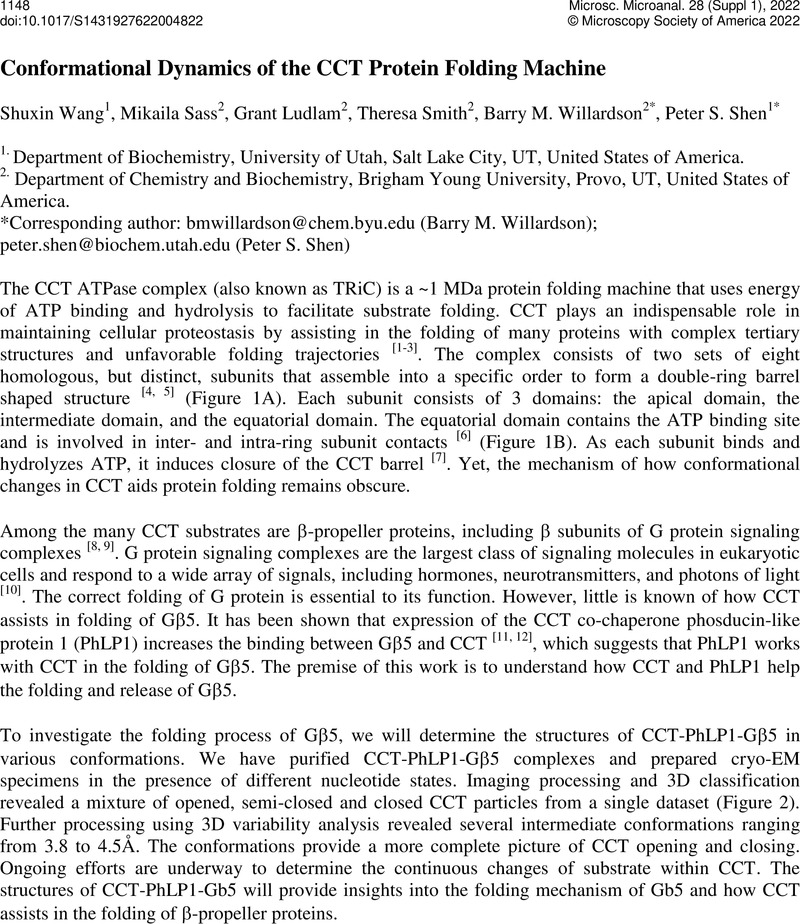No CrossRef data available.
Article contents
Conformational Dynamics of the CCT Protein Folding Machine
Published online by Cambridge University Press: 22 July 2022
Abstract
An abstract is not available for this content so a preview has been provided. As you have access to this content, a full PDF is available via the ‘Save PDF’ action button.

- Type
- 3D Structures: From Macromolecular Assemblies to Whole Cells (3DEM FIG)
- Information
- Copyright
- Copyright © Microscopy Society of America 2022
References
Lopez, T., Dalton, K., and Frydman, J. (2015) The Mechanism and Function of Group II Chaperonins. J Mol Biol 427, 2919-2930CrossRefGoogle ScholarPubMed
Willardson, B. M., and Tracy, C. M. (2012) Chaperone-mediated assembly of G protein complexes. Subcell Biochem 63, 131-153CrossRefGoogle ScholarPubMed
Yam, A. Y., Xia, Y., Lin, H. T., Burlingame, A., Gerstein, M., and Frydman, J. (2008) Defining the TRiC/CCT interactome links chaperonin function to stabilization of newly made proteins with complex topologies. Nat. Struct. Mol. Biol. 15, 1255-1262CrossRefGoogle ScholarPubMed
Kalisman, N., Schroder, G.F., and Levitt, M.. (2013) The crystal structures of the eukaryotic chaperonin CCT reveal its functional partitioning. Structure. 21(4): p. 540-9.CrossRefGoogle ScholarPubMed
Jin, M., et al. (2019) An ensemble of cryo-EM structures of TRiC reveal its conformational landscape and subunit specificity. Proc Natl Acad Sci USA. 116(39): p. 19513-19522.CrossRefGoogle ScholarPubMed
Munoz, I.G., et al. (2011) Crystal structure of the open conformation of the mammalian chaperonin CCT in complex with tubulin. Nat Struct Mol Biol. Jan;18(1): 14-9.CrossRefGoogle ScholarPubMed
Zhang, Y., et al. (2016) Staggered ATP binding mechanism of eukaryotic chaperonin TRiC (CCT) revealed through high-resolution cryo-EM. Nat Struct Mol Biol. Dec;23(12):1083-1091.CrossRefGoogle Scholar
Lopez, T., Dalton, K., and Frydman, J.. (2015) The Mechanism and Function of Group II Chaperonins. J Mol Biol. 427(18): p. 2919-30.CrossRefGoogle ScholarPubMed
Stein, K.C., Kriel, A., and Frydman, J.. (2019) Nascent Polypeptide Domain Topology and Elongation Rate Direct the Cotranslational Hierarchy of Hsp70 and TRiC/CCT. Mol Cell. 75(6): p. 1117-1130 e5.CrossRefGoogle ScholarPubMed
Sriram, K. and P.A. (2018) Insel, G Protein-Coupled Receptors as Targets for Approved Drugs:How Many Targets and How Many Drugs? Mol Pharmacol. 93(4): p. 251-258.CrossRefGoogle ScholarPubMed
Lai, C.W., et al. (2013) Phosducin-like protein 1 is essential for G-protein assembly and signaling in retinal rod photoreceptors. J Neurosci. 33(18): p. 7941-51.CrossRefGoogle ScholarPubMed
Lukov, G.L., et al. (2006) Mechanism of assembly of G protein betagamma subunits by protein kinase CK2-phosphorylated phosducin-like protein and the cytosolic chaperonin complex. J Biol Chem. 281(31): p. 22261-74.CrossRefGoogle ScholarPubMed
We thank EM core at University of Utah for assistance with data collection on the Titan Krios. Funding: This work was supported by National Eye Institute, National Institutes of Health R01EY012287.Google Scholar





